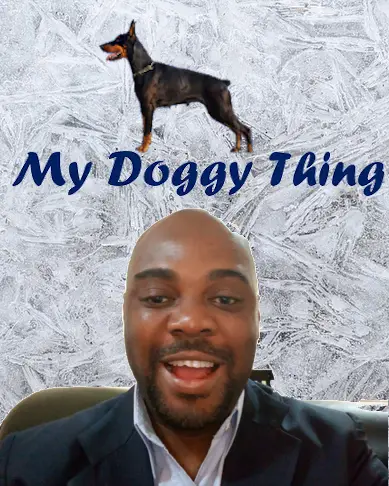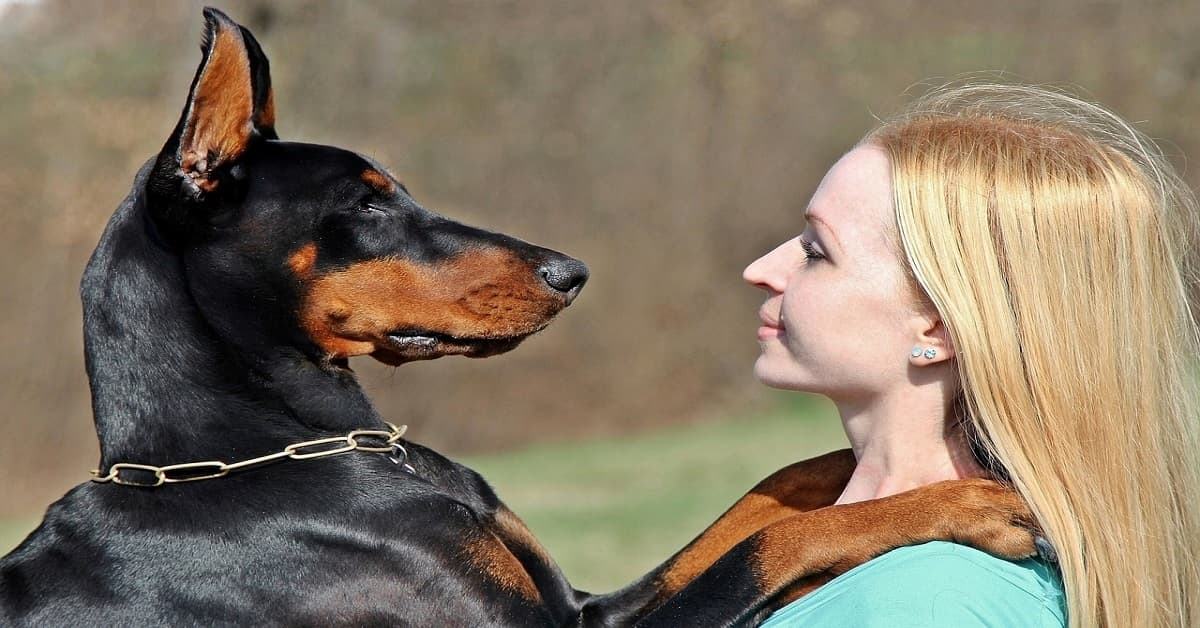Yes, you don’t need to say it. It can be really frustrating having your dog incessantly jumping on you while taking a walk. This is especially more annoying if your dog scratches or bites you in the process. You are almost tempted to send them to an animal shelter or leave them on the street.
Interestingly most dog parents one way or the other pass-through this phase, but when they succeed in dealing with the issue, they don’t think much about it. This becomes a thing of the past. If you are here it’s obvious you are asking yourself the question “Why does my dog jump on me while walking”.
To summarize it the answer to the question “Why does my dog jump on me while walking” The simple answer is that it is usually a behavioral problem. This can be broken down to the following reasons:
- Play: Your dog just wants to play with you.
- Attention: Your dog is pleading or requesting your attention for something.
- Anxiety: Your dog may be going through separation anxiety problems.
- Overstimulation: Your dog may be too stimulated or hyperactive at that moment.
- Frustration: Your dog may be frustrated and is lashing out.
.
.
Now let’s look at these points individually and more importantly understand how we can handle our dogs in each state.
Play.
Puppies and young dogs are most likely to behave this way. They have a natural tendency to put their paws on people as they are still learning to interact with us. They have lots of energy to dissipate and what better way to do this than to play with their favorite person. More so, you have a situation where they have not gotten much activity throughout the day and you come back home from work wanting to relax and they are supercharged excited to see you, and ready to go.
So what do you do? The basic dog training guideline is that you ignore behaviors that you don’t like in your dog. So in this situation, to stop your dog from jumping and nipping at you, ignore him totally. Any move you make in reaction to the situation would be seen as a form of encouragement to your young dog or puppy, unless you are initiating some form of punishment immediately which would be putting them on time out in their crates immediately or something else approved by your dog trainer. Even yelping or making hurt sounds would be seen as a form of encouragement. So, simply ignore them totally when they jump playfully on you and give them attention when they have taken the position or stance that you want.
Attention
Sometimes, your dog can feel lonely and would desire your attention, your dog may jump on you simply to bring your attention back to him or her. In most cases, this type of attention-seeking is not so aggressive. It is usually followed by a deep look into your eyes as if trying to make a connection. It is usually ok to pet and assure your dog that everything is ok and that you are in it with him or her for the long haul. Remember, this type of situation is not an everyday occurrence and you need to be observant and understand your dog’s mode in other to understand this. Basically, you should always revert to the default training mode of ignoring the action that comes with too much energy or play.
Anxiety
Your dog jumping on you during your walks can be a sign of anxiety. Before we go into this, it’s important to understand that there are different sources of anxiety for our dogs. The popular one dog parents know about is separation anxiety, but dogs can develop anxiety from the fear of loud noises, changes in their environment, and changes in people around them. One of these or all of these can lead to your dog becoming anxious and jumping on you, in some cases nipping on you.
So let’s see how to stop a dog from jumping and nipping from anxiety. It actually depends on what is causing the anxiety. Normal positive reinforcement techniques can do a lot of wonders for dogs undergoing anxiety attacks. There is also the need for proper socialization, especially when environments are changed. This helps our dogs to get used to the surroundings and their associated noises making them more attuned and relaxed in the environment. In extreme cases, there might be a need to put the dog under medication. These can only be done on the recommendation of a vet doctor.
Overstimulation
This is a state of being above excitement in our dogs. Imagine yourself being so happy, that you throw yourself on the floor, roll around and keep laughing. Well, that is the similar state of being in our dogs when they are overstimulated. Our dogs have normal sensory receptors which react to normal stimulus in their nervous system. The senses of taste, smell, physical feelings, hearing and seeing, this is all well and good as far as they receive information for their normal day to day activities, but when they are oversensitized it becomes a major problem.
This leads to the question, how can these sensory receptors get oversensitized? Imagine a situation where a lot of people begin to pet your dog continuously for a long period of time non-stop. In the beginning, this may be fun, but as it progresses you will notice that your dog starts to get more and more excited than usual. Another scenario is a situation where your dog is thrust into the midst of a high traffic area. The sounds from the different and large number of vehicles coupled with excessive human activities can be overwhelming, especially for dogs who are predisposed to hunting.
So what can we do for the dogs that jump on us in this situation? Well, first and foremost, staying calm and controlling the situation is very important as your dog will take cues from you on how to act. Socializing your dog not just with his or her immediate environment, but also with the people and other animals in the vicinity is important. Engaging your dog in both physical and mental exercises is key as this helps them to rationalize the situation around them and finally engage them in a good obedience training program. Doing these things would help you to manage your dog’s overstimulation problem properly.
Frustration
Basic pain or discomfort which cannot be expressed properly can lead to frustration. This is true for both man and dog. In the case of our dogs, this frustration may arise from trying to force him or her to do something they don’t want to do, fighting with a neighbors dog, or a medical problem causing them pain which they can’t easily relieve.
For a dog undergoing a frustrating scenario, there is nothing much that can be done at that moment, this is why it is always advised to engage your dog in some form of an obedience training program. This will help your dog to understand acceptable behaviors and keep in line. He or she would also learn to look up to you in all situations. It is also important to keep a regular date with your vet clinic. Unseen pain points and updated health status will help you better understand the situation when dealing with your dog.
So basically the five reasons above are the scenarios in which your dog may jump on you while walking. We tried to make the explanations above concise. Use the strategy below on how to stop a dog from jumping and nipping to manage the jumping situation.
How to stop a dog from jumping up when walking.
Withdraw attention at the moment.
This is the first part of teaching your dog not to jump on you. You can do this in the following way
i.) As soon as your dog jumps on you, turn your back to him as if you are concentrating on something more important than him or
ii.)Remove yourself from the scene altogether, just walk out of your dog. This may be hard for some people but remember it’s for your dog’s own good.
Reward your dog for good behavior.
You have to keep this low key especially when you are trying to teach him not to jump on you. A little pat on the head or a small treat can be given when your dog presents himself to you with all four paws on the ground.
Teach your dog the sit command.
When your dog begins to understand that you want his or her paws on the floor, then it is time to start teaching them the sit command. This is likely to take several sessions as your dog would not get it at the beginning. Be patient, have enough treats to reward them when they achieve the command, and more importantly, try and make the process enjoyable for you and your dog.
Begin the socialization process.
If you have not already started this, the socialization process simply means getting your dog to know his environment and the people and animals around the vicinity. This is something underlooked but has a very powerful effect on how your dog interacts with people.
You can first start by incorporating other people into the training process. This way, your dog starts to realize that how he behaves around you is the same way he is expected to behave around other people.
Take him or her on walks around the neighborhood, it’s good especially when you start it at an early stage. They start to be comfortable with the people’s movement, the cars or whatever machinery around you, the noise associations, and all worth not. In fact, a well-socialized dog gets to be a better member of the community or area of abode and would easily and quickly be able to spot things out of place.
Socialization is one of the main tactics for training police and military dogs, which makes them so efficient.
Vet Clinic Visits
Do not forget to maintain a regular checkup routine and also build a relationship with a vet doctor in order to have someone to reach out to in case of emergencies.
Things not to do.
Do not use punishments while training your dog. It is imperative to avoid things that can cause pain to our dogs. Simple time outs in a locked up crate can suffice for our dogs. Beware of the dog that doesn’t get enough rest during the day.
Do not yank compulsively on the leash while correcting your dog.
Avoid using the knee to chest correction method. This method uses the knee put on the dog’s chest to create a separation making it uncomfortable for your dog to jump on you. The problem is you may unknowingly injure your dog in that area leading to more health complications, also most dogs don’t get the cue fast and might think it’s a way of you playing leading to encouraging the jumping act.
So there you have it. You are now well equipped to stop your dog from jumping up when walking. Good luck

Hi, I am Charles Nwankwo Editor-in-Chief, Mydoggything.com. Gleaning from Professional Dog Trainers, behaviorist, Registered Veterinarians, and Breeders. We are passionate about making dog care easy for you. My job is to make sure that you get the best-updated dog care information to understand and take care of your dog or dogs.

